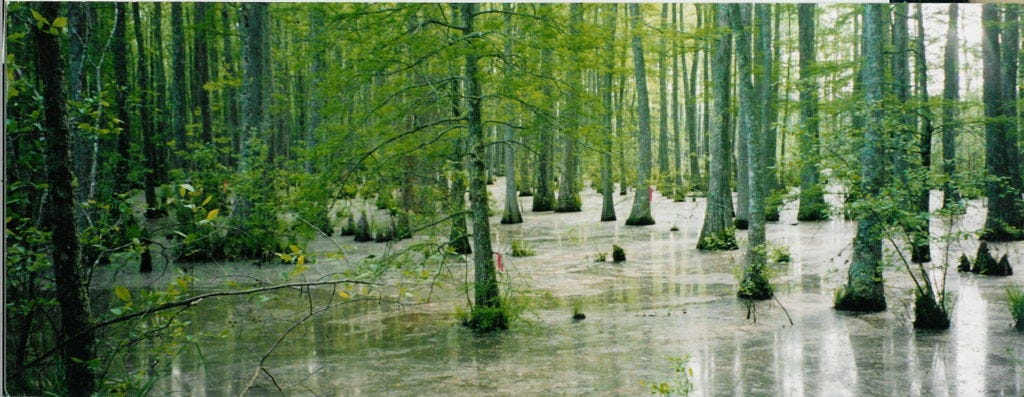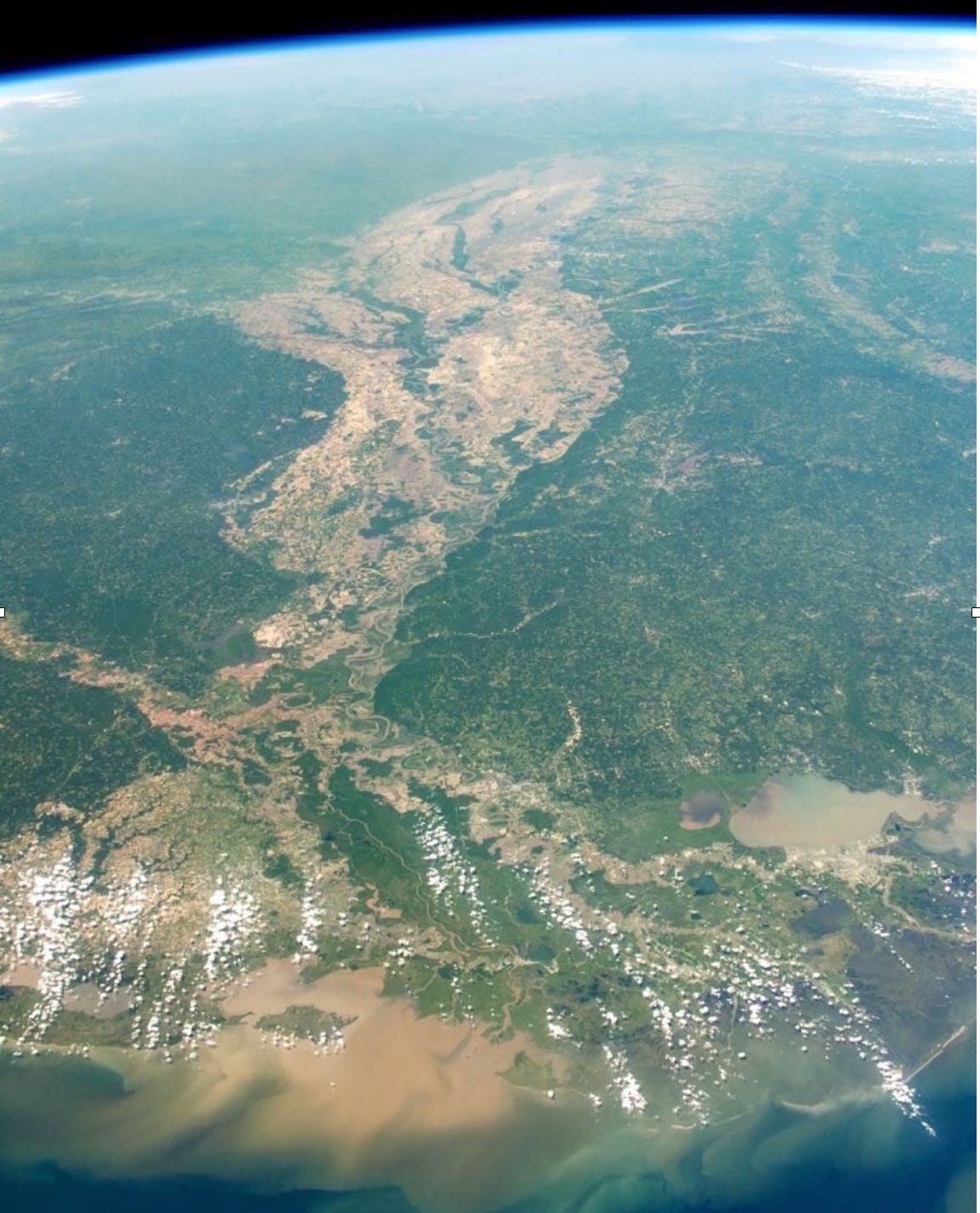The Alluvial Bottomland Boom
The Mississippi Valley is set to become an epicenter of a new reforestation industry

A wave of carbon offset projects are coming—and they're coming for the Mississippi Alluvial Valley. More on that below, but first, news from around the Southlands…
💦 The long-awaited lawsuit has dropped: Louisiana oyster growers, paired with environmental groups, have sued several federal agencies over a plan to open a “sediment diversion” meant to fight coastal land loss. (Times-Picayune)
+ The Mid-Barataria diversion may be the largest ecosystem restoration project in the country, but it’s unlikely to be enough. (Southlands)
😶🌫️ The “black snow” blowing off Florida’s burned sugar fields is a threat to public health—and to Everglades conservation. Florida writer Michael Adno went deep on the problem. (Rolling Stone)
+ A prominent Everglades scientist will be jailed for allegedly stealing “trade secrets” (Inside Climate News)
🌲 Far short of its 2025 goals, a conservation group focused on longleaf pines has decided to temper its ambitions. One key problem: restoring this essential Southern ecosystem will mean releasing more carbon in the short term. (Inside Climate News)
+ Longleaf pines, an overlooked American marvel (Southlands)
🐻 A petition to stop the pending Louisiana black bear hunt is quickly gaining signatures. (The Illuminator)
+ The Louisiana Department of Wildlife & Fisheries will hold three public meetings on the hunt in January (LDWF)
+ Black bears and the ethic of the hunt (Southlands)
♻️ The EPA has given Louisiana oversight over local carbon capture projects. (Fox 8)
+ Meanwhile, local opposition to such projects continues to build. (The Lens)
+ A look at Lake Maurepas, one of the contentious carbon storage sites (Southlands)
🐊 The New Republic goes long on the Yazoo Pumps in the Mississippi Delta—a “dubious” and “racially charged” project, as the headline puts it, accurately. Reporter Nick Schwellenbach notes that some of the claims about how the project will serve environmental justice were walked back in the wake of his records requests.
+ The Yazoo Pumps simply do not solve the real problems (Southlands)
🛶 I’ve linked to several stories on the potential Ocmulgee National Park in Georgia over the past year, but this feature in Atlanta Magazine is one of the more illuminating that I’ve read. “This,” writes Allison Entrekin, “would be the first park comanaged by a removed Native American tribe.”
The Alluvial Bottomlands Boom
When the first white men floated south into what we know today as Mississippi in 1673, they were not in love with the landscape they found.1 The mosquitoes were so thick as to be nearly intolerable. That was one unhappy consequence of the fact that the continent’s big river was surrounded by a mass of swamp forest that spanned, in places, nearly a hundred miles east to west. Today, ecologists call this kind of water-growing forest bottomland hardwoods.
They’re typically not an easy place—wet and muddy, so full of vegetal life that to walk through the woods, earlier white travelers needed hatchets to hack open a path.2 Perhaps it’s not surprising that for the past few centuries, the focus has been on chopping down trees to create something more economically useful. Once steam-powered railroads and steam-powered dredgers entered the picture in the late nineteenth century, this once-impossible landscape was shorn clear. The result is one of the most conspicuously treeless landscapes on Earth.
Recently, though, a new economy has begun emerging—one that is set to bring some of those trees back. The Mississippi’s “alluvial valley” may just become the epicenter of reforestation carbon credits in the United States.

A tech company named Pachama has launched a 7,200-acre reforestation project in Louisiana. A group called Chestnut Carbon is planting bottomland hardwood forests at various sites across Arkansas, including several sites on the western edge of the alluvial valley. Nonprofits are eying the potential too: both Ducks Unlimited and The Nature Conservancy are pursuing pilot carbon credit projects in the alluvial valley. (Disclosure: Both organizations have hired me for communications and research work related to these projects.3)
I’m assuming my readers know how carbon credits work. In short, the organization managing each carbon credit project will pay landowners along the river to turn some of their marginal, swampy ground—land that was cleared for agriculture, but probably never should have been—with new bottomland hardwood trees. (Ducks Unlimited, for example, is paying $2,200 per acre, parceled out over five years.) As the trees grow, they’ll pull carbon from the air and turn it into biomass; after several years, once the trees are big enough, the project sponsors can sell carbon credits to companies interested in “offsetting” their climate impacts, thereby recouping the costs they paid to landowners.
Perhaps this all sounds humdrum. People have been talking for years about the power of tree planting; even Donald Trump, as president, got behind a global campaign to plant a trillion trees. Here’s the thing, though: despite all the hype around tree-planting, reforestation carbon credit projects are very rare. As of late 2023, Verra, the world’s largest certifier of voluntary carbon offsets, had registered more than 2,000 projects across the world, in all kinds of categories. Around 150 involved reforestation—and only three of those reforestation projects were in the U.S.
Why is reforestation so rare? I’ve asked that of a lot of people in the carbon credit world, and the answer I hear, generally, is the relative expense of tree planting. It’s a lot cheaper to just pay someone not to cut down existing trees—under the assumption that every tree that’s not cut down means more carbon kept out of the atmosphere. When carbon credits first took off, such forest protection programs became common.
The problem, though, is that such projects presume the targeted forests were destined to be cut. Many investigations, including, most recently, a big piece in The Guardian, have found that in many cases, the supposedly protected trees were in little danger of being cut down any time soon. (In 2021, in the wake of such criticism, the Nature Conservancy conducted an internal review and ultimately canceled some of its forest-protection credits.)
Lately, as the carbon credit market has matured, and as companies have tightened their internal standards, the price for offsets has increased enough. Companies want better carbon credits, in essence, and will pay more. So tree planting looks more appealing.
Trees aren’t a panacea. Trees can burn, for example, sending the offsets up in smoke. But the Mississippi Alluvial Valley isn’t particularly fire-prone. And while planting trees in the wrong places can lead to rapid die-offs, or overconsumption of water, or can displace locals, the Mississippi Alluvial Valley is far from the wrong place: this was once, after all, one of the world’s great forests. (And, tragically, its Indigenous people were displaced almost two hundred years ago, so that question is moot.) It’s telling to me that all three Verra-registered U.S. reforestation projects are in the Mississippi Alluvial Valley.
This is not the first time that people have worked to reforest the land along the Mississippi River. In the late 1980s, when the great rush of land-clearing finally came to an end—with 80% of the old forests gone—farmers began to realize they’d been overzealous. They’d cleared some acres that were simply too low and swampy for crops. The federal government stepped in and began to pay money to recreate forests. The alluvial valley spans 24 million acres, though, and over the past thirty years, only a million acres of forest have been restored.
For now, the new carbon projects are hardly even a drop in the bucket—they don’t yet sum to more than ten thousand acres, by my count—but we can hope this is a new door opening. Nearly every year, there is a waiting list of local landowner who want to be paid to reforest their land but receive no federal money. (More good news: The Inflation Reduction Act will increase the amount of funding for the Agricultural Conservation Easement Program by $1.4 billion, or 28%, adding another potential boost to local tree planting.)
In addition to the carbon stored, the uptick in forests will be good for wildlife, from waterfowl to black bears. The new forests, by storing rainfall, could help decrease local floods. But there is one big thing the new carbon offset projects won’t do: the Mississippi Alluvial Valley is an empire of private land. There was once a great forest here, a forest that belonged to everyone, or maybe belonged to no one. The forest is coming back, in bits and pieces, but that doesn’t meant you’ll be allowed to step through those woods.
A note on Substack: As you may have heard, this platform has a Nazi problem—or a willingness to profit off of popular white supremacist and Nazi-supporting publications. Though Substack has started to make some positive changes, there are other reasons to consider other platforms; I am researching a potential change. If you have thoughts on the issue, please reach out—I’d love to talk more about it.
Quick links
More Florida seagrass = more manatees
What kind of racket do 43,000 monkeys make in Texas?
The great N.C. tobacco underground
The Chesapeake menhaden fight resumes
Tens of thousands of Mississippi River cigarette butts
Eastern forests are on the verge of failure
Louisiana shrimpers endure “the worst year”
N.C.’s Clingmans Dome may become Kuwohi
This was the voyage of Father Jacques Marquette and fur trader Louis Joliet, specifically.
It’s worth noting that before Marquette and Joliet arrived, Indigenous societies used controlled fires to help keep some of the local forests cleared. But—thanks to a grim combination of disease, warfare, and slave-raiding—the human population of the Mississippi Alluvial Valley had plummeted over the few centuries preceding the Frenchmen’s travels.
Specifically, I’ve written a magazine story about DU’s “Flyway Forest” program, which will appear in the next issue of Wetlands America magazine; and, on behalf of the Nature Conservancy, I’ve conducted a series of interviews with various locals who hold some stake in local reforestation. Shameless plug: If your organization is interested in similar work, please reach out to Alluvial Studio—the new design agency I’m quietly launching with Liz, and which now sports a work-in-progress website.




Alluvial Studio looks great, and like the name...The Ducks Unlimited carbon credit effort made me think of the Ducks Unlimited Park in Arkansas across the Mississippi River from Memphis https://www.ducksunlimitedpark.com/. I had heard they plan to convert at least some of the land there back to forested wetlands but hadn't heard of the broader effort Ducks Unlimited has throughout the Mississippi Alluvial Valley. It sounds like a good way to bring back natural habitats with many positive effects.
Wondering if you should put the word "allegedly" in front of "stealing trade secrets."